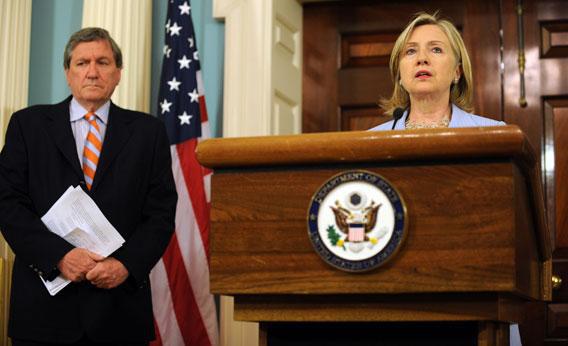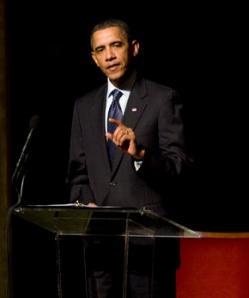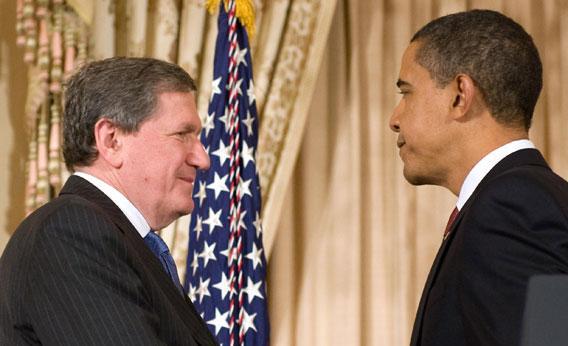Following is an excerpt from James Mann’s The Obamians, out today from Viking.
It seemed almost foreordained that Richard Holbrooke would have a difficult, unhappy stint in the Obama administration. He had the wrong history, personality, and operating style to fit in with the Obama inner circle, much as Holbrooke struggled in his own fashion to do so. He was of the wrong generation, serving at the wrong time.
Holbrooke was a living symbol of the foreign-policy establishment against which the Obama team had campaigned. He had been serving Democratic presidents since the 1960s. The Obamians saw themselves as insurgents; Holbrooke had always tied himself to power, to worldly, prosperous Democrats like Averell and Pamela Harriman, Clark Clifford and the Clintons.*
Holbrooke would almost certainly have been secretary of state if Hillary Clinton had won the presidency. He might also have landed that job if Al Gore had won in 2000 or if John Kerry had beaten George Bush in 2004. After Obama appointed Clinton as secretary, she hoped to name Holbrooke her deputy, but Obama gave that job to Jim Steinberg, who had been a leading candidate for national security adviser.
Instead, in 2009, eager to return to government, Holbrooke took the lesser job he was offered, as the president’s special representative for Afghanistan and Pakistan, or “Af-Pak,” as he soon called it. He found himself, for the third time in his career, working within but not quite at the top of a Democratic administration, obliged to serve under those who seemed to know less history (and fewer powerful people) than he did. He was working for a secretary of state whom he had tutored in foreign policy and for a president who had been seven years old in 1968, when Holbrooke began working for Harriman at the Paris peace talks on Vietnam.
by James Mann.
The rationale for giving Holbrooke the “Af-Pak” job was that while his outsize personality might create problems in Washington, he was especially good at fixing specific, hands-on problems overseas. Together, the wars against the Taliban in Afghanistan and against al-Qaida in Pakistan were among the highest priorities for the new administration. The Af-Pak assignment was meant to be a follow-on to the work Holbrooke had done in the Balkans during the Clinton administration. There, Holbrooke had managed to push, shove, and cadge the leaders of Bosnia, Serbia, and Croatia into accepting the Dayton peace settlement. His aggressive operating style had served him well in dealing with Serbia’s Slobodan Milosevic. a tough leader who needed to hear some blunt language and threats along with the standard diplomatic niceties.
The problem was that Hamid Karzai, the president of Afghanistan, did not stand in the same position as Milosevic in the 1990s. The Serbian leader was an adversary; Karzai was a shaky ally. Holbrooke could threaten Milosevic that if he balked, he might confront awesome American military power (and, indeed, the United States and its NATO allies eventually did bomb Belgrade). Holbrooke couldn’t similarly threaten Karzai with the bombing of Kabul. Ultimately, the Obama administration needed the help and cooperation of Karzai’s government. The applicable historical precedent for dealing with Karzai wasn’t Milosevic at all. Rather, the closer comparison was those leaders aligned with the United States in the Cold War who proved increasingly unpopular at home and obstreperous in dealing with Washington. Both Nguyen Van Thieu in South Vietnam and Ferdinand Marcos in the Philippines fit this description well.
* * *
Holbrooke quickly ran into even more serious problems in Washington. In the fall of 2009, the underlying tension and mistrust between Holbrooke and the Obama White House boiled to the surface. The precipitating factor was a profile of Holbrooke in The New Yorker. Written by George Packer, the article was entitled “The Last Mission.” It told the story of Holbrooke’s career from his early days serving in the Vietnam War to his new job in the midst of the war in Afghanistan. There were reflections by Holbrooke on the lessons from Vietnam for Afghanistan, comparisons and contrasts between the two countries, and pictures of Holbrooke in both Vietnam and Afghanistan—all of them introduced by a glossy portrait photograph of Holbrooke, covering one and a third pages.
Denis McDonough, the deputy national security adviser, who rarely said or did anything without the president’s approval, summoned Holbrooke to the White House for a strained conversation. Holbrooke and McDonough were probably the two most press-conscious officials in the entire administration: Neither was modest about calling reporters to try to shape a story in advance or to complain about something after it appeared. But the similarities stopped there. Holbrooke called the press on matters involving himself or his own causes and issues; McDonough was a staff man who pushed, equally aggressively, on behalf of his boss Obama.
At their meeting, McDonough dressed down Holbrooke, pointing his finger for emphasis. He told Holbrooke that the president was unhappy about the magazine article, which had drawn attention to Holbrooke, not the administration, and portrayed Afghanistan in a way that centered on Holbrooke’s own story. The White House wanted to set the messages and images of the administration, and not have various individual actors send out a cacophony of ideas.
* * *
On Sunday, Dec. 5, 2010, Richard Holbrooke played tennis on Long Island with Bill Drozdiak, the president of the American Council on Germany, a former foreign correspondent who became friendly with Holbrooke when both were living in Europe. They played for about an hour. Drozdiak thought Holbrooke seemed unusually pale, pudgy and out of shape, as if he’d been working too hard.
Afterward, they sat and talked. Holbrooke said he was in despair over his role in the administration. He simply could not establish a relationship with Obama, Holbrooke said. The president seemed remote and cold-blooded, at least in Holbrooke’s presence. And, as if that weren’t enough, Holbrooke’s problem wasn’t just with Obama: Holbrooke thought many in the White House were against him, especially McDonough, who had been with Obama since the earliest stages of his 2008 campaign.

TIM SLOAN/AFP/Getty Images.
Still, Holbrooke hoped somehow to leverage his many connections into a wider role in the administration. He was an old friend of Tom Donilon, who had a few weeks earlier become Obama’s national security adviser. Maybe things will improve, Holbrooke told Drozdiak.
The following Friday, Holbrooke was at a meeting in Hillary Clinton’s State Department office when he suddenly became flushed and stricken with pain. He was taken to the State Department medical office, but collapsed and went by ambulance to George Washington University Hospital. He died there three days later of a ruptured aorta.
* * *
Holbrooke’s death represented, in many ways, a passing of the old guard in American foreign policy. He was the link to the Democratic Party of the Vietnam era. His ideas and career reflected the party’s prolonged ambivalence about what to say and do in the aftermath of that disaster.
In the 1970s, Holbrooke had been among the Democrats’ intellectual leaders in trying to define America’s role in the world after the elder statesmen from the Kennedy and Johnson administrations—the Rusks and McNamaras, Bundys and Rostows—had been discredited.
On the one hand, Holbrooke could sound passionately liberal as he attacked the Republicans during general elections and the periods when the Democrats were out of office. He embraced important causes such as stopping the spread of AIDS. He thought of Vietnam as a terrible mistake, one the United States should never repeat.
Yet within the Democratic Party and during Democratic primaries, Holbrooke was definitely not a man of the political left. He did not ally himself with antiwar movements or candidates, whether George McGovern in 1972 or Obama in 2008. A year after the end of the Vietnam War, he specifically denounced “the guilt-ridden anguish of the left.”
Instead, Holbrooke invariably placed himself close to the Democratic Party’s center of gravity, alongside established forces and elites rather than insurgent movements. To a considerable extent, this reflected his ambition and his fascination with power, his perpetual urge to be on the inside, his sense that those in antiwar movements or insurgencies didn’t know the way things really worked (and also didn’t know the right people, the ones on his long contact list).
Yet along with these personal factors, Holbrooke’s determined centrism reflected a set of underlying beliefs. He was not opposed to the use of force, especially not for humanitarian purposes in places like Bosnia and Kosovo. He did not believe America was inherently malign. He argued repeatedly that the United States should continue to play a powerful role in the world.
The great irony was that Barack Obama, the president with whom Holbrooke did not get along, eventually embraced many of these same centrist views himself. After he became president, Obama made clear through his actions that despite his opposition to the Iraq War, he was no pacifist. On the contrary, he was quite willing to wield military power (ground troops in Afghanistan, SEAL teams on killing missions in Pakistan) and technology (drones in country after country) on behalf of America’s interests and values. If Holbrooke was respectful of money, comfortable with financial power and the world of Wall Street, Obama was hardly a populist on economic issues himself.
In their beliefs, then, the two men turned out to be not too far apart. In their personalities, however, they were strikingly different. Holbrooke was aggressive, emotional, dramatic, persistent, preoccupied with the personal, and consumed with whatever was happening at that moment. Obama remained cool, restrained, impersonal, far less swept up in the news coverage of the day, more preoccupied with long-term strategy, more driven to challenge established political power.
* * *

Kristoffer Tripplaar/Getty Images.
The memorial service for Holbrooke, held at the Kennedy Center, was a Washington event like few others. This was in some ways surprising. By way of comparison, three months later Holbrooke’s former boss, Warren Christopher, died. During his Washington career, Christopher had held two jobs, secretary of state and deputy secretary, that Holbrooke, despite his aspirations, never reached. Christopher also ran the high-level negotiations that brought American hostages home from Iran in early 1981. Yet in the nation’s capital, Christopher’s death was a one-day story; no big memorial service commemorated his life. Holbrooke, by contrast, had the biggest, mostly highly attended Washington memorial service of any political or foreign-policy leader since the state funerals of Ronald Reagan and Gerald Ford. Pakistan’s President Asif Ali Zardari flew in from Pakistan for the ceremonies, along with other foreign-policy luminaries.
President Obama spoke in Holbrooke’s honor, and so did both Bill and Hillary Clinton. All of them praised Holbrooke, yet there was also a certain undertone to the proceedings, the legacy of his difficult time in the Obama administration. Holbrooke had been one of the stars of the Clinton administration; in the Obama administration, he was forced into the limited role of a character actor. To the Clintons and their associates, Holbrooke was Our Crowd; to the Obama administration he was Their Crowd.
Bill Clinton gave a speech that was typically effusive (“I loved the guy. … If you knew him, you had to love him”), but also pointed and obliquely political, with remarks that could have been aimed at Obama: Although Holbrooke had a few “rough edges,” the former president said, “I could never understand people who didn’t appreciate him.” (Left unsaid was that Bill Clinton himself had passed over Holbrooke for secretary of state at least twice in 1992 and 1996—three times, if one includes the time in 1994 that Clinton tried unsuccessfully to bring in Colin Powell as secretary of state.) Hillary Clinton, her face strikingly animated, both warm and sad, spoke of Holbrooke in personal terms, smiling at his foibles: “He’d walk into meetings to which he was not invited, act like he was meant to be there, and just start talking.” When he did something no one else would do, she said, she and her associates would just say, “That’s Richard being Richard.”
It was Obama who sought to put Holbrooke into a broader context, one that went beyond his personality. He depicted Holbrooke against the background of American foreign policy and the generational changes within it. “In many ways, he was the leading light of a generation of American diplomats who came of age in Vietnam,” said Obama. “It was a generation that came to know both the tragic limits and awesome possibilities of American power—born at a time of triumph in World War II; steeped in the painful lessons of Southeast Asia; participants in the struggle that led ultimately to freedom’s triumph during the Cold War.”
In the days afterward, some of Holbrooke’s friends and the Clinton crowd murmured privately that Obama had been off key, that he seemed too aloof in speaking about Holbrooke, that he had been graceful but a bit stinting with his praise. After a few more months, Holbrooke’s friends and family became more public in criticizing the Obama White House. He “was effectively gagged, unable to comment on what he saw as missteps of the Obama administration that he served,” wrote Nicholas Kristof.
Holbrooke had indeed been gagged, prevented from appearing on news shows or talking on the record to the news media—although had he been allowed to appear, he would almost certainly have publicly praised and defended the administration in which he served. From the perspective of the Obama White House, Holbrooke had been reined in because, merely by appearing regularly on the talk shows, he would have called attention to himself and assumed more power than the president and his aides were willing to hand over. They did not want Holbrooke to shape the stories that were written or told about the administration, the narratives that they wanted to control on their own. It turned out that the only drama in which Holbrooke had the lead role during the Obama administration was his own tragedy.
Holbrooke’s widow Kati Marton told the Kristof that Holbrooke had compared Afghanistan to Vietnam. “He thought that this could become Obama’s Vietnam,” she said. “Some of the conversations in the Situation Room reminded him of conversations in the Johnson White House. When he raised that, Obama didn’t want to hear it.”
He certainly didn’t.
Excerpted from The Obamians: The Struggle Inside the White House to Redefine American Power. Published by Viking. Copyright James Mann, 2012.
Correction, June 14, 2012: This article originally misspelled the first name of Averell Harriman.
